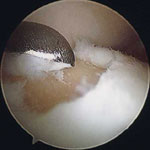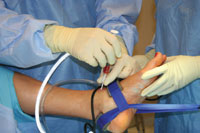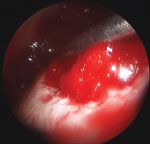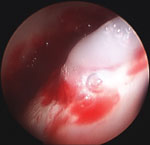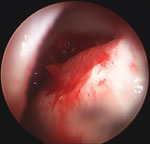Stem cell-rich collagen paste can successfully repair osteochondral defects
Click Here to Manage Email Alerts
Many options exist for regenerating cartilage to repair osteochondral defects in the talus. The use of microfracture to form fibrocartilage is a widely accepted treatment modality for osteochondral defects, but it is well known that fibrocartilage is not as durable as hyaline cartilage. These lesions tend to do worse with increasing size, especially above 1 cm2. There has been much success in the laboratory with use of a 3-D matrix to hold stem cells. As a result, we developed a new treatment at our institute for osteochondral defects using a stem cell-rich paste composed of bone marrow aspirate mixed with particulate collagen/glycosaminoglycan, which is an extension of the microfracture concept with a goal of better durability.
The technique stems from a similar technique used at the Rizzoli Institute by Francesca Vannini, MD, and Sandro Giannini, MD, who used matrix-induced autologous chondrocyte implantation or MACI (Genzyme Europe BV; Naarden, The Netherlands) disks to hold either culture chondrocytes or concentrated bone marrow aspirate in order to regenerate a hyaline cartilage surface. These matrices are not available in the United States, so we use collagen from Integra Life Sciences that is usually used for wound filling as the substrate for our stem cells found in concentrated bone marrow aspirate. Our surgical concept is to increase the number of stem cells and provide a 3-D scaffold that will form hyaline cartilage instead of fibrocartilage.
Making the paste
To create the stem-cell rich paste, 60 mL of bone marrow is harvested using a trocar from the ipsilateral iliac crest of the patient at the time of surgery. The marrow is filtered and spun down with centrifugation to concentrate it; it is then mixed with Integra Flowable Collagen to make a stem cell-rich paste.
The technique was initially performed arthroscopically with the grafting done under dry scope. We found that an open arthrotomy is easier to mold the paste into the defect and, thus, often use an open technique now, frequently using a small plafondplasty to see the lesion. We very rarely perform tibial osteotomy anymore.
|
Images: Miller SD |
Once the talar defect is defined with resection of damaged cartilage and then microfractured with the awl, the graft can be performed. We add a drop of fibrin glue (Tisseel; Baxter Healthcare Corporation, Westlake Village, Calif.) to the base of the osteochondral defect and then add the stem cell-rich paste into the defect, over which we add two or three more drops of fibrin glue. After initial set-up of the fibrin glue, we often release the traction on the joint, letting the corresponding tibial surface give the appropriate contour to the fibrin glue topping. We then immobilize patients for 1 week in a splint, and then put them in a nonweightbearing walker boot for 4 weeks to 6 weeks.
The best candidates for stem cell-rich collagen paste have defects deeper than 1 cm. Anecdotally, younger patients will do better than older ones (better stem cell populations in the bone marrow). Exclusion criteria might include candidates with a “kissing” lesion in the tibia, repeat microfractures or defects greater than 1 cm deep (which would require a bone grafting procedure underneath the stem cell-rich paste).
More durable fill
This technique has produced excellent results in maintaining ankle joint viability and mobility in patients. Our goal to produce hyaline cartilage patches that are more durable than fibrocartilage scars seems reachable. The stem cell-rich collagen paste returned many patients to normal activity. Stem cell-rich paste may be a better alternative than microfracture surgery alone because the hyaline cartilage presumably created by the paste is more durable than the fibrocartilage formed following microfracture.
|
|
|
Two patients who did not improve needed DeNovo NT Natural Tissue Grafts (Zimmer; Warsaw, Ind.) juvenile cartilage allografts. Patients with defined, discrete lesions had better outcomes than those with more damage to the articular surface. There was no significant morbidity and the safety of the procedure is on a par with microfracture.
Thus far, Lew C. Schon, MD, and I performed the procedure on 20 patients in a 3-year period with a number of successes. One exemplary patient had complete resumption of athletic activity including returning to marathon running.
|
|
|
|
Future plans
We continue to follow-up patients who underwent this procedure. The next step is to collect outcomes of our MRI findings to examine the regeneration of appropriate cartilage signals. We also plan to evaluate how natural the cartilage looks on MRI and intend to study the clinical differences between arthroscopic and open arthrotomy techniques.
The procedure is similar to the technique we use for DeNovo cartilage allografts. We continue to use DeNovo grafts in some patients and stem-cell rich collagen paste in others as we try to determine the best technique for patients. We will also conduct a study comparing patient outcomes for those undergoing DeNovo allografting vs. stem cell-rich collagen paste.
Reference:
- Miller SD, Schon LC. A new technique: Arthroscopic filling of osteochondral defects with stem cell-rich collagen paste. Paper #7. Presented at the 2011 Annual Meeting of the American Orthopaedic Foot and Ankle Society. July 13-16. Keystone, Colo.

- Stuart D. Miller, MD, can be reached at Greater Chesapeake Orthopaedic Associates LLC, 3333 North Calvert St., Suite 400, Baltimore, MD; 410-554-6530; email: stubonedoc@aol.com.
- Disclosure: Miller is a consultant to Integra and Biomet.

